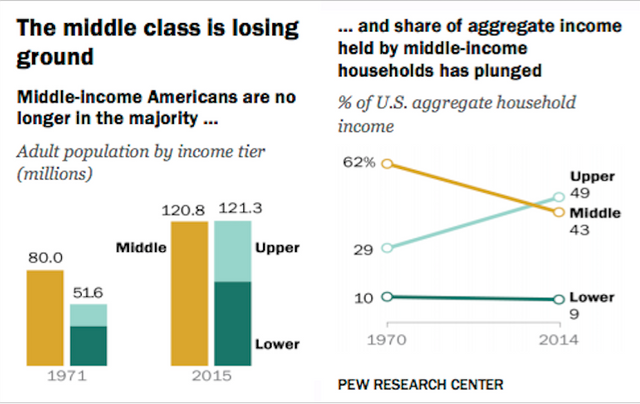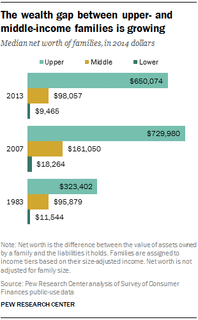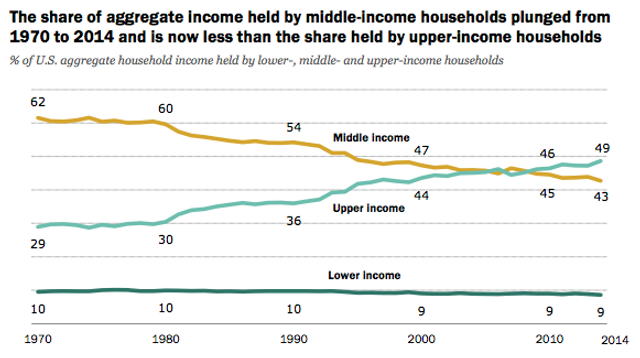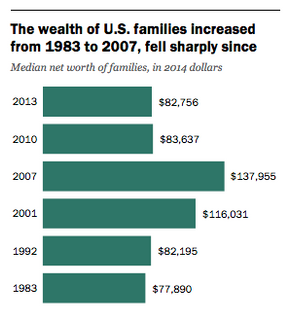Impoverishment of the Middle Class in America: Middle-income Households No Longer The Majority

For the first time in more than four decades, “middle-income households” no longer constitute the majority of American society, according to a study published Wednesday by the Pew Research Center. Instead, the majority of households are either low or higher-income.
The study concluded, “Once in the clear majority, adults in middle-income households in 2015 were matched in number by those in lower- and upper-income households combined.” Pew called its findings “a demographic shift that could signal a tipping point” in American society.
The study also found a sharp fall in household incomes and wealth, particularly for low-income households, noting that only “upper-income families realized notable gains in wealth from 1983 to 2013.”

Together with the decline in the relative numbers of middle-income earners, the incomes of households in this group has fallen substantially in recent decades. The median income of middle-income households fell by four percent between 2000 and 2014, while their median wealth fell by 28 percent over approximately the same period.
The study notes that since 1983, the total share of income accruing to high-income households has grown significantly. The study found that “fully 49% of US aggregate income went to upper-income households in 2014, up from 29% in 1970.” Meanwhile the share “accruing to middle-income households was 43% in 2014, down substantially from 62% in 1970.”

These findings reflect the persistent declines in wages for US workers following decades of de-industrialization, which has been accompanied by significant increases in the yields of financial assets, helping to increase the wealth and earnings of the financial elite, along with a section of upper middle-class households.
While the study’s metrics are too broad to capture the enormous concentration of society’s wealth in the hands of the top 1 and 0.1 percent, they reflect the reality that a “middle class” lifestyle is increasingly out of reach for the broad majority of the US population.
The Pew study, an analysis of data from the Census Bureau’s current population survey, defines “middle-income” households as those earning between two-thirds and twice the US median household income, or between $42,000 to $126,000 for a household of three. Those classified as low-income made less than two-thirds the typical income, while those classified as high-income made twice the median income.
The study added that the fastest growing sections of the population were those at the extremes of the income distribution: the very rich and the very poor. “The movement out of the middle has not simply been at the margins—the growth has been at the extreme ends of the income ladder,” with “the fastest-growing numbers… in the very lowest and very highest income tiers.”
The study found that, after dividing US households into fifths based on household income, “In 2015, 20% of American adults were in the lowest income tier, up from 16% in 1971. On the opposite side, 9% are in the highest income tier, more than double the 4% share in 1971.” Meanwhile the share of adults in the lower middle or upper middle income brackets have remained unchanged.

The report added, “The growth at the top is similarly skewed,” as “the share of adults in highest-income households [has] more than doubled, from 4% in 1971 to 9% in 2015. But the increase in the share in upper-middle income households was modest, rising from 10% to 12%.”
The study further noted the impact of the 2008 crisis on the wealth of middle-income households. It stated,
“Before the onset of the Great Recession, the median wealth of middle-income families increased from $95,879 in 1983 to $161,050 in 2007, a gain of 68%. But the economic downturn eliminated that gain almost entirely. By 2010, the median wealth of middle-income families had fallen to about $98,000, where it still stood in 2013.”
The wealth of higher income households has largely been protected from the 2008 financial crash.
“Upper income families more than doubled their wealth from 1983 to 2007 as it climbed from $323,402 to $729,980. Despite losses during the recession, these families recovered somewhat since 2010 and had a median wealth of $650,074 in 2013, about double their wealth in 1983.”

The Pew figures also show the impact of the persistent economic slump on a broad range of households, noting,
“Americans are less well-to-do now than at the start of the 21st century. For all income tiers, median incomes in 2014 were lower than in 2000. These reversals are the result of two recessions—the downturn in 2001 and the Great Recession of 2007-09—and economic recoveries that have been too anemic to fully repair the damage.”
The conclusion that the incomes and wealth of all sections of society have declined since the start of the 2008 crisis is attributable to the fact that the study’s methodology is too broad to encompass the most dramatic change in American society: the enormous concentration of wealth and income in the hands of the financial oligarchy. The handful of multi-millionaires and billionaires in this social group are wealthier than ever.
Figures published last year by professors Emmanuel Saez and Gabriel Zucman showed that the wealthiest 0.5 percent of American society saw their share of the country’s wealth double, from about 17 percent in 1978 to just under 35 percent in 2012. The top 0.1 percent (one one-thousandth of the population) now controls more than 20 percent of all wealth, up from about 8 percent in the late 1970s.
The vast growth of social inequality is not the result of an impartial and merely objective process, but is rather the result of policies pursued by the government for decades aimed at slashing the wages and benefits of American workers while enriching the financial oligarchy that dominates wealth and political power in the US. This process has been dramatically accelerated under the Obama administration.
The persistent growth of social inequality is the most conspicuous and defining characteristic of contemporary American society. It is this process, facilitated by the financialization of the economy and the continuous diversion of resources away from productive investment, that underlies the erosion of democratic forms of government and the endless promotion of war and militarism.
This process expresses, moreover, a deep social crisis to which the financial elite, obsessed with the expansion of its own wealth and social privilege, can offer no solutions.

